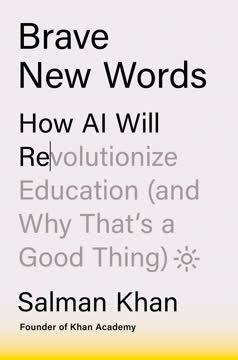Key Takeaways
1. Strategic thinking is essential for business leaders and can be developed
Strategic thinking is the set of mental disciplines leaders use to recognize potential threats and opportunities, establish priorities to focus attention, and mobilize themselves and their organizations to envision and enact promising paths forward.
Strategic thinking capacity equation. A leader's strategic thinking capacity (STC) can be expressed as:
STC = Endowment + Experience + Exercise
- Endowment: Natural ability from genetics and upbringing
- Experience: Engagement in situations that develop strategic thinking
- Exercise: Mental work to build strategic thinking muscles
Six disciplines of strategic thinking:
- Pattern recognition
- Systems analysis
- Mental agility
- Structured problem-solving
- Visioning
- Political savvy
These disciplines collectively enable leaders to navigate complex business environments, identify opportunities and threats, and mobilize their organizations effectively.
2. Pattern recognition enables identification of threats and opportunities
If you can better recognize patterns in complex, fast-changing environments, you can act more rapidly and effectively than your competitors.
Developing pattern recognition. Leaders can enhance their pattern recognition abilities through:
- Learning about underlying mechanisms of human pattern recognition
- Immersing themselves in specific domains of interest
- Engaging with experts to understand how they separate signal from noise
Benefits of strong pattern recognition:
- Rapid identification of emerging threats and opportunities
- Improved decision-making in complex environments
- Ability to anticipate and respond to market changes faster than competitors
Pattern recognition forms the foundation for strategic thinking, allowing leaders to make sense of vast amounts of information and focus on what truly matters.
3. Systems analysis helps build simplified models of complex domains
Systems analysis is a holistic approach that focuses on the connections and interactions between the elements of a system rather than on the individual components in isolation.
Key concepts in systems analysis:
- Elements: Components of the system
- Interconnections: How elements interact
- Purpose or function: The system's overall goal
Applications of systems analysis:
- Organizational design: Understanding how different parts of a business interact
- Supply chain management: Identifying potential vulnerabilities and improving efficiency
- Strategy development: Anticipating how changes in one area might affect others
By developing strong systems analysis skills, leaders can better manage complexity, identify leverage points for change, and design more effective strategies. This discipline complements pattern recognition by providing a framework for understanding how different elements in a business environment interact and influence each other.
4. Mental agility allows flexible thinking and anticipation of scenarios
Level-shifting lets you explore challenges and opportunities from multiple, complementary perspectives.
Two key components of mental agility:
- Level-shifting: Ability to analyze situations at different levels (big picture to fine details)
- Game-playing: Anticipating actions and reactions of other "players" in business scenarios
Developing mental agility:
- Practice intentional level-shifting in daily work
- Engage in activities that develop game-playing abilities (e.g., chess, simulations)
- Use scenario planning to explore potential futures and strategic options
Mental agility enables leaders to adapt quickly to changing circumstances, consider multiple perspectives, and anticipate potential outcomes of their decisions. This flexibility is crucial in today's rapidly evolving business environment.
5. Structured problem-solving guides systematic analysis and solution development
Structured problem-solving is the strategic-thinking discipline that guides you in how to solve your organization's most important challenges.
Five phases of structured problem-solving:
- Define roles and communicate the process
- Frame the problem
- Explore potential solutions
- Decide on the best option
- Commit to a course of action
Key elements of effective problem framing:
- Define the problem as a specific question
- Clarify evaluation criteria for potential solutions
- Identify significant potential barriers to overcome
Structured problem-solving provides a systematic approach to addressing complex organizational challenges. By following this process, leaders can ensure thorough analysis, stakeholder alignment, and effective implementation of solutions.
6. Visioning creates compelling future images to motivate organizations
A vision is a compelling mental picture of how the organization will look and feel when the strategy is fully realized.
Components of effective visioning:
- Personal vision: Leader's clear, desirable future state
- Shared vision: Co-created vision that aligns with organizational values
- Powerful simplification: Communicating the vision in clear, evocative terms
Benefits of strong visioning:
- Aligns and motivates employees around common goals
- Provides direction and purpose for the organization
- Supports building alliances and stakeholder buy-in
Visioning helps leaders create a compelling picture of the future that inspires and guides their organizations. It bridges the gap between current realities and potential futures, providing a roadmap for strategic action.
7. Political savvy navigates organizational dynamics to build alliances
Political savvy is the ability to navigate and influence the political landscape of organizations.
Key elements of political savvy:
- Understanding power dynamics and stakeholder motivations
- Building and leveraging networks of relationships
- Crafting effective influence strategies
Seven tools for exerting influence:
- Consultation
- Framing
- Social pressure
- Choice-shaping
- Entanglement
- Sequencing
- Action-forcing events
Political savvy enables leaders to navigate complex organizational dynamics, build alliances, and implement their strategic visions effectively. It is essential for mobilizing resources and support for strategic initiatives.
8. Developing strategic thinking requires gaining experience and exercising your brain
It is possible to boost your brainpower to develop the six disciplines.
Strategies for gaining experience:
- Show you see the big picture in current roles
- Demonstrate critical thinking abilities
- Develop and articulate points of view on strategic issues
- Highlight ability to observe trends and envision potential futures
Exercises for developing strategic thinking:
- Pattern recognition: Immerse in specific domains, engage with experts
- Systems analysis: Practice analyzing real-world systems, work on case studies
- Mental agility: Practice level-shifting, engage in game-playing activities
- Structured problem-solving: Apply the five-phase process to various challenges
- Visioning: Practice microvisioning, use the architect's exercise
- Political savvy: Observe and analyze political landscapes, study influence dynamics
Consistently practicing these exercises can help leaders develop their strategic thinking abilities, regardless of their starting point.
9. Building a strategic-thinking team amplifies organizational capabilities
To develop the strategic-thinking capacity of your team, first help your team understand what strategic thinking is and isn't.
Strategies for developing team strategic thinking:
- Encourage a culture that values strategic thinking
- Provide development opportunities (workshops, mentoring, expert learning)
- Foster collaboration and idea-sharing
- Invest in action learning and experimentation
Benefits of a strong strategic-thinking team:
- Broader perspectives and more comprehensive analysis
- Increased innovation and adaptability
- Better alignment and execution of strategic initiatives
By developing strategic thinking capabilities across the team, leaders can amplify their organization's ability to navigate complex challenges and capitalize on opportunities.
10. The future demands even greater strategic thinking skills
Strategic thinking has always been an essential capability for business leaders, but it will likely become even more important.
Factors increasing the importance of strategic thinking:
- Growing complexity, uncertainty, volatility, and ambiguity in business environments
- Increasing importance of innovation and creativity
- Rise of data analytics and AI in decision-making
- Growing interconnectedness of global markets
Future applications of strategic thinking:
- Navigating technological disruptions
- Managing increasingly complex stakeholder relationships
- Balancing short-term pressures with long-term sustainability
- Addressing global challenges (climate change, geopolitical shifts)
As the business world becomes more complex and interconnected, the ability to think strategically will become an even more critical differentiator for successful leaders and organizations. Continuous development of strategic thinking skills will be essential for navigating the challenges and opportunities of the future.
Last updated:
FAQ
What's "The Six Disciplines of Strategic Thinking" about?
- Comprehensive Guide: The book by Michael D. Watkins is a comprehensive guide to strategic thinking, offering insights and tools for leaders to navigate complex environments.
- Six Disciplines: It introduces six mental disciplines essential for strategic thinking: pattern recognition, systems analysis, mental agility, structured problem-solving, visioning, and political savvy.
- Real-World Application: Through real-world examples, such as the transformation of Carolinas HealthCare System, the book illustrates how these disciplines can be applied to lead organizations into the future.
- AI Integration: The book also discusses the role of artificial intelligence in enhancing strategic thinking, emphasizing a symbiotic relationship between human leaders and AI systems.
Why should I read "The Six Disciplines of Strategic Thinking"?
- Leadership Development: It is essential for leaders who want to improve their ability to anticipate and respond to challenges in a rapidly changing world.
- Practical Tools: The book provides practical tools and frameworks that can be applied to real-world business scenarios.
- Future-Proofing Skills: It prepares leaders to leverage AI and other technological advancements in strategic decision-making.
- Comprehensive Approach: The book covers a wide range of strategic thinking aspects, making it a valuable resource for both new and experienced leaders.
What are the key takeaways of "The Six Disciplines of Strategic Thinking"?
- Six Disciplines: Mastering the six disciplines of strategic thinking is crucial for effective leadership.
- AI's Role: Artificial intelligence will play a significant role in future strategic thinking, providing new insights and enhancing decision-making.
- VUCA Environment: Leaders must navigate a VUCA (volatility, uncertainty, complexity, ambiguity) world, making strategic thinking more critical than ever.
- Continuous Development: Strategic thinking is a skill that can be developed through experience, exercise, and exposure to new challenges.
What is the definition of strategic thinking according to Michael D. Watkins?
- Mental Disciplines: Strategic thinking is defined as the set of mental disciplines leaders use to recognize threats and opportunities, establish priorities, and mobilize their organizations.
- Beyond Present Situations: It involves looking beyond the present and thinking critically and creatively about potential futures.
- Decision-Making: Strategic thinking enables leaders to make informed decisions in the face of uncertainty and change.
- Building Blocks: The book emphasizes isolating specific building blocks of strategic thinking to assess and develop this skill effectively.
How does Michael D. Watkins suggest leaders develop their strategic-thinking ability?
- Endowment, Experience, Exercise: Watkins suggests focusing on three elements: natural endowment, gaining experience, and exercising strategic-thinking muscles.
- Experience Opportunities: Leaders should actively seek opportunities to demonstrate and develop their strategic-thinking skills.
- Mental Exercises: Regular mental exercises, such as scenario planning and role-playing, can enhance strategic-thinking capabilities.
- Feedback and Reflection: Seeking feedback and reflecting on experiences are crucial for continuous improvement in strategic thinking.
What role does AI play in strategic thinking according to "The Six Disciplines of Strategic Thinking"?
- Data Processing: AI can process large amounts of data, identify patterns, and make predictions, providing leaders with new insights.
- Symbiotic Relationships: The book envisions a future where leaders and AI systems work together to enhance decision-making and strategy development.
- Real-Time Insights: AI systems can offer real-time data and analysis, helping leaders make more informed decisions.
- Ethical Considerations: Leaders must also consider the ethical and societal implications of using AI in strategic thinking.
What is the "recognize-prioritize-mobilize" cycle in strategic thinking?
- Cyclical Process: The recognize-prioritize-mobilize (RPM) cycle is a process where recognition of problems leads to prioritizing and mobilizing resources to address them.
- Rapid Response: Moving quickly through RPM cycles helps leaders and their teams respond faster than competitors.
- Pattern Recognition: Effective pattern recognition is crucial for identifying threats and opportunities in the RPM cycle.
- Strategic Application: The cycle is applied in real-world scenarios, such as Gene Woods' leadership at Carolinas HealthCare System.
How does "The Six Disciplines of Strategic Thinking" address the VUCA environment?
- Complexity Management: Systems analysis helps leaders manage complexity by building simplified models of business domains.
- Uncertainty Navigation: Strategic thinkers use anticipation and scenario planning to navigate uncertainty.
- Volatility Response: Leaders must rapidly sense and respond to volatility, adapting strategies as needed.
- Ambiguity Resolution: Political savvy and structured problem-solving help leaders negotiate ambiguity and align stakeholders.
What are some of the best quotes from "The Six Disciplines of Strategic Thinking" and what do they mean?
- "Insight is power." This emphasizes the importance of pattern recognition in gaining a competitive edge by acting more rapidly and effectively than competitors.
- "Strategic thinking is the fast lane to the top." It highlights the correlation between strategic-thinking skills and leadership effectiveness and growth potential.
- "The formulation of a problem is often more essential than its solution." This quote underscores the importance of problem framing in structured problem-solving.
- "Visioning is helping the organization understand where you want to go." It reflects the role of visioning in aligning and motivating an organization towards a common goal.
How can leaders improve their pattern-recognition abilities according to Michael D. Watkins?
- Immersion: Leaders should immerse themselves deeply in selected business domains to build powerful mental models.
- Expert Engagement: Working closely with experts in apprenticeship-like relationships can enhance pattern-recognition skills.
- Curiosity Cultivation: Cultivating curiosity and casting a wide net for information sources helps in recognizing emerging trends.
- Feedback Utilization: Good feedback is a powerful tool for developing pattern-recognition abilities by reinforcing associations between cues and strategies.
What is the importance of visioning in strategic thinking?
- Direction and Purpose: Visioning provides a clear picture of the organization's future, aligning behavior and motivating employees.
- Shared Vision: Developing a shared vision helps overcome self-interest and factionalism, uniting the organization towards common goals.
- Powerful Simplification: Communicating the vision in straightforward, evocative terms is crucial for galvanizing support.
- Vision Stories: Using stories and metaphors can effectively communicate the vision and inspire action.
How does "The Six Disciplines of Strategic Thinking" suggest leaders navigate organizational politics?
- Embrace Politics: Leaders must embrace politics and understand the underlying power dynamics to build alliances.
- Influence Strategies: Crafting influence strategies involves consultation, framing, social pressure, and sequencing.
- Emotional Intelligence: High emotional intelligence is essential for reading others' emotions and effectively influencing them.
- Network Building: Building and leveraging a network of relationships is crucial for navigating internal and external political landscapes.
Review Summary
The Six Disciplines of Strategic Thinking receives generally positive reviews, with readers praising its comprehensive approach to strategic thinking skills. Many find it informative, practical, and essential for navigating complex business environments. The book's structured framework and actionable advice are appreciated. Some readers note its academic tone, while others find it inspiring and applicable to various career levels. A few criticisms mention the book's obvious content and perceived lack of originality. Overall, reviewers recommend it for leaders and professionals seeking to enhance their strategic thinking abilities.
Similar Books










Download PDF
Download EPUB
.epub digital book format is ideal for reading ebooks on phones, tablets, and e-readers.





